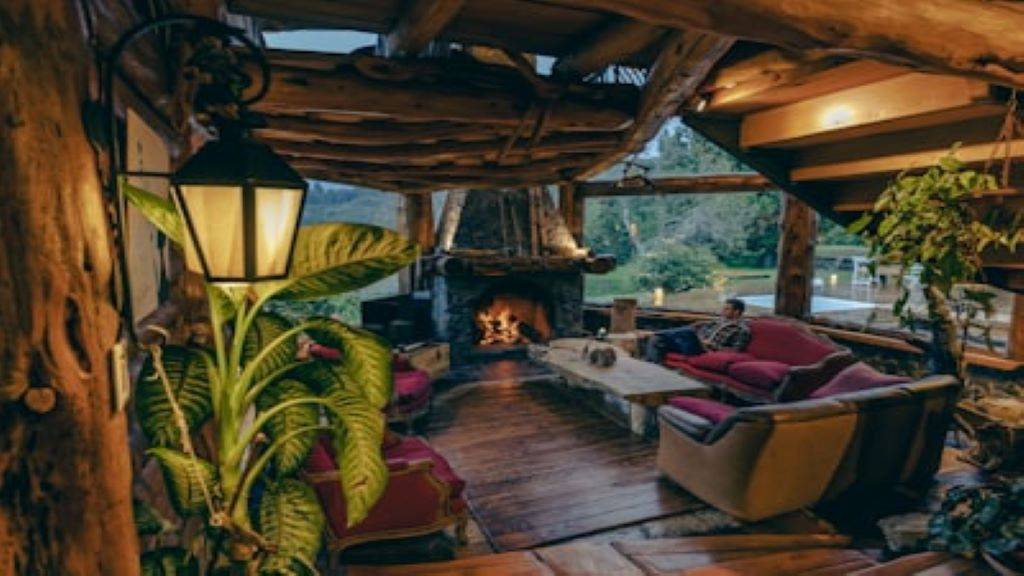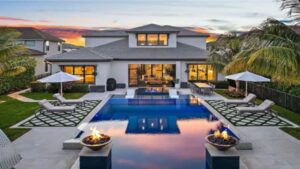Imagine waking up to misty mountain views, surrounded by untouched nature, in your own private getaway. A mountainside retreat offers this life-changing escape from everyday life, creating a personal paradise where nature is right next door.
Designing your dream cabin requires careful planning that goes beyond just looks. Your retreat should blend seamlessly with its natural surroundings while providing the comfort and peace you desire. The secret is finding the perfect balance between modern comforts and rustic beauty.
Creating your ideal mountainside escape involves several important factors:
- Crafting a clear vision that aligns with your lifestyle
- Selecting the perfect location that speaks to your soul
- Choosing materials that can withstand nature’s forces
- Incorporating sustainable practices that protect the environment
- Adding personal touches that make your retreat uniquely yours
A well-designed mountain retreat becomes more than just a building – it becomes a living space that nurtures your connection with nature and offers a serene getaway from the world below.
1. Envisioning Your Dream Mountainside Retreat
Creating your perfect mountainside retreat starts with a clear, compelling vision. Start by building a digital inspiration board on platforms like Pinterest or Instagram, collecting images that resonate with your dream cabin aesthetic. Save photos of architectural elements, interior layouts, and outdoor spaces that catch your eye.
Your vision can draw inspiration from multiple sources:
- Natural Elements: Study the surrounding landscape’s colors, textures, and materials. Pine forests might inspire warm wood tones, while rocky terrain could influence stone accent walls.
- Architectural Styles: Research different cabin designs:
- A-frame structures for dramatic snow-shedding rooflines
- Traditional log cabins for rustic charm
- Modern minimalist designs with large windows
- Scandinavian-inspired cottages for clean lines
Personal Experiences shape your design goals. Think about:
- Memorable stays at mountain lodges or cabins
- Features you’ve appreciated in other homes
- Activities you plan to enjoy in your retreat
- Specific needs of family members or frequent guests
Transform your collected inspiration into practical design goals. Create a list of must-have features:
- Number of bedrooms and bathrooms
- Kitchen layout preferences
- Specific views you want to capture
- Indoor-outdoor living spaces – consider designing seamless indoor-outdoor spaces to enhance your retreat’s connection with nature
- Storage requirements
- Special areas for hobbies or activities
Your vision serves as a roadmap for every decision in the design process, from selecting materials to planning the layout of your mountain sanctuary.
2. Choosing the Perfect Location for Your Cabin
Your retreat location shapes every aspect of your mountain sanctuary experience. A thoughtfully selected site creates the foundation for your dream cabin’s success, influencing both its visual appeal and practical functionality.
Essential Location Factors to Consider:
- Slope and Terrain: Understand the natural drainage patterns, sun exposure throughout seasons, views and vantage points, and soil stability for construction.
- Climate Considerations: Take into account snowfall patterns and accumulation, wind exposure and direction, temperature fluctuations, and rainfall intensity.
- Accessibility Features: Assess road conditions year-round, emergency service availability, distance from main roads, and winter access capabilities.
- Proximity to Resources: Evaluate water source reliability, power grid connection options, local building materials, and basic amenities and supplies.
Conducting a thorough site analysis can help you make informed decisions about these factors. A south-facing slope often provides optimal sunlight exposure while offering protection from harsh northern winds. Your chosen site should balance privacy with practical access to necessities. Consider seasonal changes – a serene summer spot might become challenging during winter months.
Local zoning laws and building regulations vary by region. Research permit requirements, property boundaries, and environmental protection zones before finalizing your location choice. A site visit during different weather conditions helps you understand the land’s behavior throughout the year.
The perfect retreat location combines natural beauty with practical functionality, creating a space where you can truly disconnect while maintaining essential comforts and safety measures.
3. Collaborating with Architects and Designers to Bring Your Vision to Life
Working with experienced architects and designers can turn your dreams of a mountain getaway into reality. These experts have a deep understanding of the unique challenges posed by mountain landscapes, such as steep slopes, harsh weather conditions, and limited access points. They also possess knowledge of local building regulations and design solutions that are tailored to elevated areas.
Key Benefits of Professional Collaboration:
- Expert guidance on structural requirements for mountain conditions
- Access to innovative design solutions and materials
- Knowledge of local building regulations and permit processes
- Professional project management and timeline coordination
- Cost-effective solutions through industry connections
Effective Communication Strategies:
- Create a detailed project brief
- List must-have features and design preferences
- Include budget constraints and timeline expectations
- Share inspiration photos and reference materials
- Maintain open dialogue
- Schedule regular progress meetings
- Ask questions about design decisions
- Request 3D renderings for better visualization
- Document everything
- Keep written records of all decisions
- Save sketches and design iterations
- Store material samples and color schemes
Professional designers can help you maximize views through strategic window placement, create energy-efficient layouts, and design spaces that flow naturally with the mountainous landscape. Their expertise ensures your retreat not only looks stunning but functions perfectly in its environment.
Remember to choose professionals with proven experience in mountain architecture. Ask to see their portfolio of similar projects and request references from past clients who built retreats in comparable locations. It’s also essential to understand the broader context of building in mountainous regions, which includes various legal, environmental, and logistical considerations that these professionals can help navigate effectively.
4. Choosing Durable Materials for Mountain Conditions
When building a cabin in the mountains, it’s crucial to use materials that can withstand the harshness of nature. The choices you make for your cabin’s construction will affect how long it lasts, how much upkeep it needs, and its overall look.
Weather-Resistant Materials to Consider:
- Cedar and Douglas Fir logs – naturally resistant to decay and insect damage
- Metal roofing – shields against heavy snow loads and prevents ice dam formation
- Double-pane windows – provide insulation and protection against strong winds
- Stone veneer – adds durability and rustic charm to exterior walls
- Treated lumber – essential for decks and outdoor structures
Important Factors When Choosing Materials:
- Thermal Performance – Select materials with high R-values to maintain comfortable indoor temperatures
- Moisture Resistance – Choose materials designed to prevent water damage and mold growth
- UV Protection – Opt for materials that won’t fade or deteriorate under intense sun exposure
- Wind Resistance – Pick materials rated for high-wind conditions common at higher elevations
Mountain environments test materials through extreme temperature swings, heavy precipitation, and intense UV exposure. Investing in quality materials like durable logs and weather-resistant siding saves money long-term by reducing maintenance costs and extending your retreat’s lifespan.
Consider local climate patterns when selecting specific materials. Areas with heavy snowfall benefit from steeper roof pitches and stronger support structures, while regions with high rainfall require superior waterproofing solutions.
5. Building Your Retreat: DIY vs Hiring Professionals
Building a mountainside retreat presents two distinct paths: self-build cabin construction or hiring professional contractors. Each approach carries unique advantages and considerations for your project.
Self-Build Benefits:
- Complete control over construction timeline
- Significant cost savings on labor
- Personal satisfaction and connection to the build
- Flexibility to adjust plans during construction
Self-Build Challenges:
- Requires extensive construction knowledge
- Time-intensive commitment (12-18 months average)
- Need for specialized tools and equipment
- Potential for costly mistakes
Professional Contractor Benefits:
- Expert knowledge and experience
- Access to quality materials and resources
- Faster completion (6-8 months average)
- Guaranteed workmanship and warranties
Professional Contractor Considerations:
- Higher upfront costs (30-40% above DIY)
- Less direct control over daily decisions
- Scheduling dependent on contractor availability
- Need for clear communication and expectations
Budget Planning:
- DIY costs: $100-150 per square foot
- Professional build: $200-300 per square foot
- Additional costs for permits and inspections
- 10-15% contingency fund recommended
A hybrid approach might serve as an effective compromise – handling simpler tasks yourself while delegating complex structural work to professionals. This strategy balances cost savings with expert craftsmanship where it matters most.
6. Incorporating Sustainable Practices Into Your Cabin Design
Creating an eco-friendly mountainside retreat starts with smart sustainable choices. Your cabin can become a model of environmental responsibility through these proven practices:
Energy Solutions
- Install solar panels on south-facing roof sections
- Use LED lighting throughout the cabin
- Add smart thermostats to regulate temperature efficiently
- Implement passive solar design with strategic window placement
Sustainable Materials
- Source reclaimed wood from local demolition sites
- Use recycled metal roofing materials
- Install salvaged doors and windows
- Choose locally-sourced stone for foundations and features
Water Conservation
- Install rainwater collection systems
- Use low-flow fixtures in bathrooms
- Create a greywater system for garden irrigation
- Design drought-resistant landscaping
Insulation Innovations
- Use recycled denim or wool insulation
- Install double-pane windows with proper sealing
- Add green roofing for natural temperature control
- Incorporate thermal mass walls
The mountain environment presents unique opportunities for sustainable living. Your cabin can harness natural elements while preserving resources. Consider working with sustainability consultants who understand mountain ecosystems to maximize your eco-friendly initiatives. Local building suppliers often stock reclaimed materials that tell stories through their weathered character while reducing environmental impact.
7. Creating Inviting Outdoor Spaces That Embrace Nature’s Beauty
Your mountainside retreat’s outdoor spaces serve as natural extensions of your living area, creating seamless connections between indoor comfort and the raw beauty of the surrounding landscape. A well-designed outdoor space transforms your retreat experience by providing dedicated areas for relaxation, entertainment, and immersion in nature.
Essential Outdoor Living Elements:
- Stone pathways winding through native gardens
- Covered deck spaces for year-round enjoyment
- Natural rock fire pits for evening gatherings
- Private meditation nooks nestled in quiet corners
- Rustic outdoor kitchen setups for mountain dining
Native plants play a crucial role in creating sustainable, low-maintenance landscapes that complement your mountain setting. These hardy species naturally thrive in your local climate, requiring minimal water and care while providing year-round visual interest.
Native Plant Integration Ideas:
- Create wildflower meadows using local species
- Plant hardy evergreens for privacy screens
- Design rock gardens with drought-resistant plants
- Include native berry bushes to attract local wildlife
- Use indigenous ground covers for natural erosion control
Strategic placement of outdoor furniture and features maximizes both functionality and views. Consider positioning seating areas to capture sunrise or sunset vistas, and design outdoor spaces that offer protection from strong mountain winds while maintaining open sight lines to dramatic landscapes.
Your outdoor living spaces can include practical elements that enhance your mountain lifestyle:
- Dedicated gear storage for outdoor equipment
- Weather-resistant furniture built for alpine conditions
- Natural drainage systems that work with existing topography
- Strategic lighting for evening outdoor activities
- Sheltered areas for unexpected weather changes
8. Personalizing Your Cabin Interiors for Comfort And Style
The interior design of your mountainside retreat plays a crucial role in creating unforgettable memories. By adding personal touches, you can transform a simple cabin into your own unique sanctuary that reflects your style and offers an authentic mountain living experience.
Custom Furniture Pieces
Consider incorporating these custom furniture pieces into your cabin:
- Hand-carved wooden dining tables
- Locally crafted rocking chairs
- Custom-built window seats with storage
- Artisan-made bed frames using reclaimed timber
Distinctive Lighting Solutions
Enhance the ambiance of your cabin with these distinctive lighting solutions:
- Antler chandeliers
- Wrought iron wall sconces
- Vintage oil lanterns converted to electric
- Handcrafted pendant lights using local materials
The key to creating a warm and inviting atmosphere lies in the combination of different textures and materials. For example, you can layer soft wool throws with leather armchairs or pair rough-hewn wooden beams with smooth stone surfaces. Additionally, consider incorporating elements that tell your story:
- Family heirlooms displayed on open shelving
- Local artwork featuring mountain landscapes
- Vintage ski equipment as wall décor
- Hand-woven textiles from regional artisans
Cozy Nooks for Relaxation
Designate specific areas in your cabin for relaxation and leisure activities. Here are some ideas for creating cozy nooks:
- Reading corners with built-in bookshelves
- Window seats overlooking mountain vistas
- Breakfast nooks with custom banquette seating
- Craft spaces featuring local pottery
Nature-Inspired Color Palette
Your cabin’s interior should seamlessly blend with the surrounding landscape. Choose a color palette inspired by nature – deep forest greens, warm earth tones, and soft grays. To add character and uniqueness, opt for hardware choices such as hand-forged door handles or copper cabinet pulls that reflect the rustic charm of the mountains.
Conclusion
Creating your dream mountainside retreat opens a world of possibilities for personal expression and sustainable living. Each design choice shapes your sanctuary, from the initial vision to the final decorative touches. Your retreat becomes a testament to thoughtful planning and creative expression.
The secrets to a successful mountain cabin design lie in:
- Balancing aesthetic appeal with practical durability
- Embracing sustainable materials and energy-efficient solutions
- Incorporating personal elements that tell your unique story
- Respecting and working with the natural landscape
Your mountainside haven stands as more than just a structure – it’s your personal gateway to nature’s tranquility. By prioritizing sustainability alongside your creative vision, you create a legacy that honors both your lifestyle and the environment. The careful attention to detail in your design transforms your retreat into an inspiring sanctuary where you can truly disconnect, recharge, and immerse yourself in the mountain’s serene embrace.
Remember: your dream mountainside retreat awaits. Start your journey with passion, plan with purpose, and watch as your vision materializes into reality.








